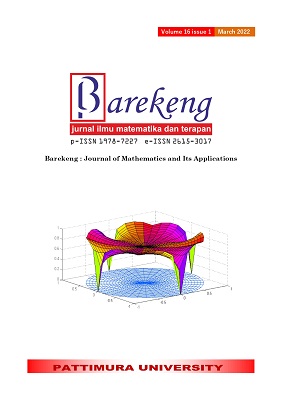TOTAL EDGE AND VERTEX IRREGULAR STRENGTH OF TWITTER NETWORK
Abstract
Twitter data can be converted into a graph where users can represent the vertices. Then the edges can be represented as relationships between users. This research focused on determining the total edge irregularity strength (tes) and the total vertices irregularity strength (tvs) of the Twitter network. The value could be determined by finding the greatest lower bound and the smallest upper bound. The lower bound was determined by using the properties, characteristics of the Twitter network graph along with the supporting theorems from previous studies, while the upper bound is determined through the construction of the total irregular labeling function on the Twitter network. The results in this study are the tes(TW)=18 and tvs(TW)=16.
Downloads
References
G. Chartrand and P. Zhang, Introduction to Graph Theory. Boston: Mc Graw-Hill Press, 2004.
M. Bača, S. Jendrol’, M. Miller, and J. Ryan, “On irregular total labellings,” Discrete Math., vol. 307, no. 11–12, pp. 1378–1388, 2007, doi: 10.1016/j.disc.2005.11.075.
J. A. Gallian, “A dynamic survey of graph labeling,” Electron. J. Comb., vol. 1, no. DynamicSurveys, 2018.
M. Bača, Z. Kimáková, M. Lascsáková, and A. Semaničová-Feňovčíková, “The Irregularity and Modular Irregularity Strength of Fan Graphs,” Symmetry (Basel)., vol. 13, no. 4, 2021, doi: 10.3390/sym13040605.
M. Bača, M. Imran, and A. Semaničová-Feňovčíková, “Irregularity and Modular Irregularity Strength of Wheels,” Mathematics, vol. 9, no. 21, 2021, doi: 10.3390/math9212710.
Slamin, “On distance irregular labelling of graphs,” Far East J. Math. Sci., vol. 102, no. 5, pp. 919–932, 2017, doi: 10.17654/MS102050919.
D. Indriati, Widodo, I. E. Wijayanti, K. A. Sugeng, and M. Bača, “On Total Edge Irregularity Strength of Generalized Web Graphs and Related Graphs,” Math. Comput. Sci., vol. 9, no. 2, pp. 161–167, 2015, doi: 10.1007/s11786-015-0221-5.
I. Rajasingh, B. Rajan, and S. Teresa Arockiamary, “Total Edge Irregularity Strength of Butterfly Networks,” Int. J. Comput. Appl., vol. 49, no. 3, pp. 21–22, 2012.
Nurdin, “Total irregular labeling of butterfly network on level two,” AIP Conf. Proc., vol. 1867, no. August, 2017, doi: 10.1063/1.4994470.
Nurdin, E. T. Baskoro, A. N. M. Salman, and N. N. Gaos, “On the total vertex irregularity strength of trees,” Discrete Math., vol. 310, no. 21, pp. 3043–3048, 2010, doi: 10.1016/j.disc.2010.06.041.
. Nurdin, M. Zakir, and Firman, “Vertex-irregular labeling and vertex-irregular total labeling on caterpillar graph,” Int. J. Appl. Math. Stat., vol. 40, pp. 99–105, Jan. 2013.
N. Hinding, H. K. Kim, N. Sunusi, and R. Mise, “On Total Vertex Irregularity Strength of Hexagonal Cluster Graphs,” Int. J. Math. Math. Sci., vol. 2021, 2021, doi: 10.1155/2021/2743858.
E. Saputra, N. Hinding, and S. Amir, “Total Irregular Labelling Of Butterfly and Beneš Network 5-Dimension,” J. Mat. Stat. dan Komputasi, vol. 17, no. 1, pp. 61–70, 2020, doi: 10.20956/jmsk.v17i1.10909.
M. Imran, A. Ahmad, M. K. Siddiqui, and T. Mehmood, “Total vertex irregularity strength of generalized prism graphs,” J. Discret. Math. Sci. Cryptogr., 2021, doi: 10.1080/09720529.2020.1848103.
M. I. Tilukay, P. D. M. Taihuttu, A. N. M. Salman, F. Y. Rumlawang, and Z. A. Leleury, “Complete bipartite graph is a totally irregular total graph,” Electron. J. Graph Theory Appl., vol. 9, no. 2, p. 387, 2021, doi: 10.5614/ejgta.2021.9.2.11.
G. K. Nandini, R. S. Rajan, A. A. Shantrinal, T. M. Rajalaxmi, I. Rajasingh, and K. Balasubramanian, “Topological and thermodynamic entropy measures for covid-19 pandemic through graph theory,” Symmetry (Basel)., vol. 12, no. 12, pp. 1–29, 2020, doi: 10.3390/sym12121992.
Authors who publish with this Journal agree to the following terms:
- Author retain copyright and grant the journal right of first publication with the work simultaneously licensed under a creative commons attribution license that allow others to share the work within an acknowledgement of the work’s authorship and initial publication of this journal.
- Authors are able to enter into separate, additional contractual arrangement for the non-exclusive distribution of the journal’s published version of the work (e.g. acknowledgement of its initial publication in this journal).
- Authors are permitted and encouraged to post their work online (e.g. in institutional repositories or on their websites) prior to and during the submission process, as it can lead to productive exchanges, as well as earlier and greater citation of published works.






1.gif)



